Chapter 3 Chemistry
Genesis of Periodic Classification Dobereiner’s Triads
In 1829, Dobereiner arranged certain elements with similar properties in groups of three in such a way that the atomic mass of the middle element was nearly the same as the average atomic masses of the first and the third elements. A few triads proposed by him are listed.
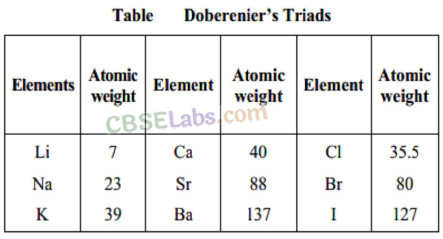
Limitations of Dobereiner’s Trids
The triads given by Dobereiner were helpful in grouping some elements with similar characteristics together, but he could not arrange all the elements known at that time into triads.
• Newlands’ Law of Octaves
John Newlands proposed the law of octaves by stating that when elements are arranged in order of increasing atomic masses, every eighth element has properties similar to the first. Newlands called it law of octaves because similar relationship exists in the musical notes also.
This can be illustrated as:
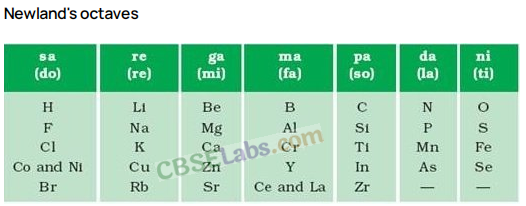
Limitations of Newlands’ Law of Octaves
(i) This classification was successful only up to the element calcium. After that, every eighth element did not possess the same properties as the element lying above it in the same group.
(ii) When noble gas elements were discovered at a later stage, their inclusion in the table disturbed the entire arrangement.
• Mendeleev’s Periodic Table
Mendeleev’s Periodic Law: The physical and chemical properties of the elements are a periodic
function of their atomic masses.
Mendeleev arranged the elements known at that time in order of increasing atomic masses
and this arrangement was called periodic table.
Elements with similar characteristics were present in vertical rows called groups. The horizontal
rows were known as periods.
Description of Mendeleev’s Periodic Table
(i) In the periodic table, the elements are arranged in vertical rows called groups and horizontal rows known as periods.
(ii) There are nine groups indicated by Roman Numerals as I, II, III, IV, V, VI, VII, VIII and zero. Group VIII consists of nine elements which are arranged in three triads. The zero group contains elements belonging to inert gases or noble gases and elements present have zero valency.
(iii) There are seven periods (numbered from 1 to 7) or, horizontal rows in the Mendeleev’s periodic table.
Importance of Mendeleev’s Periodic Table
(i) This made the study of the elements quite systematic in the sense that if the properties of one element in a particular group are known, those of others can be pridicted.
(ii) This helped to a great extent in the discovery of these elements at a later stage.
(iii) Mendeleev corrected the atomic masses of certain elements with the help of their expected positions and properties.
Defects in Mendeleev’s Periodic Table
(i) Hydrogen has been placed in group IA along with alkali metals. But it also resembles halogens of group VII A in many properties. Thus, its position is the Mendeleev’s periodic table is controversial.
(ii) Although the elements in the Mendeleev’s periodic table have been arranged in order of their atomic masses, but in some cases the element with higher atomic mass precedes the element with lower atomic mass.
(iii) We know that the isotopes of an element have different atomic masses but same atomic number. Since, periodic table has been framed on the basis of increasing atomic masses of the elements, different positions must have been allotted to all the isotopes of a particular element.
(iv) According to Mendeleev, the elements placed in the same group must resemble in their properties. But there is no similarity among the elements in the two sub-groups of a particular group.
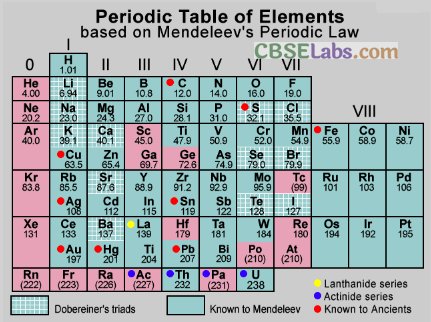
(v) In some cases, elements with similar properties have been placed in different groups.
(vi) Lanthanoids and actinoids were placed in two separate rows at the bottom of the periodic table without assigning a proper reason.
(vii) No proper explanation has been offered for the fact that why the elements placed in group show resemblance in their properties.
• Modern Periodic Law
Physical and chemical properties of the elements are the periodic function of their atomic numbers.
• Present Form of the Periodic Table (Long form of Periodic Table)
The long form of periodic table, also called Modem Periodic Table, is based on Modern periodic law. In this table, the elements have been arranged in order of increasing atomic numbers.
• Nomenclature of Elements with Atomic No. more than 100
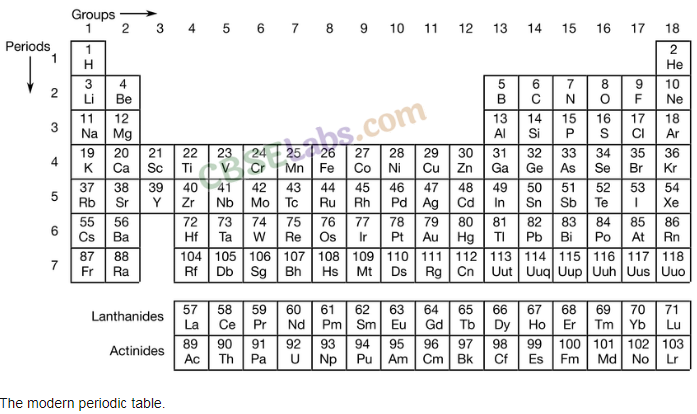
• Structural Features of the Periodic Table
Groups
The long form of periodic table also consists of the vertical rows called groups. There are in all 18 groups in the periodic table. Unlike Mendeleev periodic table, each group is an independent group.
Characteristics of groups:
(i) All the elements present in a group have same general electronic configuration of the atoms.
(ii) The elements in a group are separated by definite gaps of atomic numbers (2, 8, 8,18, 18,32).
(iii) The atomic sizes of the elements in group increase down the group due to increase the number of shells.
(iv) The physical properties of the elements such as m.p., b.p. density, solubility etc., follow a systematic pattern.
(v) The elements in each group have generally similar chemical properties.
Periods
Horizontal rows in a periodic table are known as periods.
There are in all seven periods in the long form of periodic table.
Characteristics of periods:
(i) In all the elements present in a period, the electrons are filled in the same valence shell.
(ii) The atomic sizes generally decrease from left to right.
s-Block Elements
General electronic configuration: ns1-2 Characteristics of s-block elements:
(i) All the elements are soft metals.
(ii) They have low melting and boiling points.
(iii) They are highly reactive.
(iv) Most of them impart colours to the flame.
(v) They generally form ionic compounds.
(vi) They are good conductors of heat and electricity. p-Block Elements
General electronic configuration: ns2np1-6
Characteristics of p-block elements:
(i) The compounds of these elements are mostly covalent in nature.
(ii) They show variable oxidation states.
(iii) In moving from left to right in a period, the non-metallic character of the elements increases.
(iv) The reactivity of elements in a group generally decreases downwards.
(v) At the end of each period is a noble gas element with a closed valence shell ns2 np6 configuration.
(vi) Metallic character increases as we go down the group.
d-Block Elements
General electronic configuration: (n -1) d1-10 ns0-2
The d-block elements are known as transition elements because they have incompletely filled d-orbitals in their ground state or in any of the oxidation states.
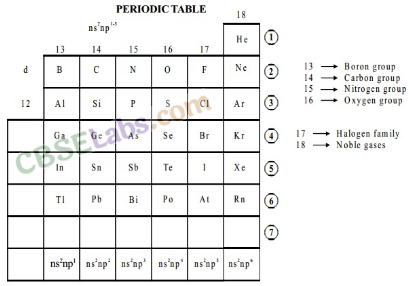
Characteristics of d-block elements:
(i) They are all metals with high melting and boiling points.
(ii) The compounds of the elements are generally paramagnetic in nature.
(iii) They mostly form coloured ions, exhibit variable valence (oxidation states).
(iv) They are of tenly used as catalysts.
f-Block Elements
General electronic configuration: (n – 2) f1-14 (n -1) d0-1 ns2
They are known as inner transition elements because in the transition elements of d-block, the electrons are filled in (n – 1) d sub-shell while in the inner transition elements of f-block the filling of electrons takes place in (n – 2) f subshell, which happens to be one inner subshell. Characteristics of f-Block elements:
(i) The two rows of elements at the bottom of the Periodic Table, called the Lanthanoids Ce (Z = 58) – Lu (Z = 71) and Actinoids Th (Z = 90) – Lr (Z = 103).
(ii) These two series of elements are called Inner Transition Elements (f-Block Elements).
(iii) They are all metals. Within each series, the properties of the elements are quite similar.
(iv) Most of the elements pf the actinoid series are radio-active in nature.

Comments
Post a Comment